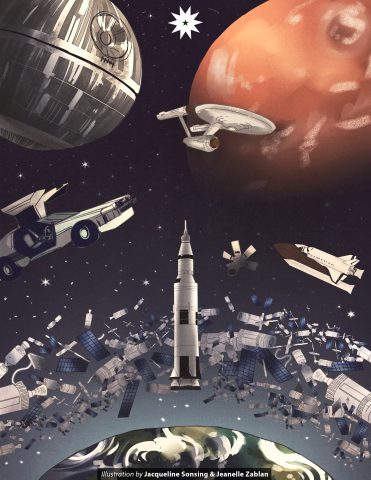While taking in the vast expanse that is our universe, humanity has tried time and time again to comprehend the many elements hidden within. We once turned to gods and deities to bring society to order and hopefully make sense of the world around us, until we eventually built our own tools to survive and understand its complexities—ultimately creating the space for us to explore the infinity and beyond.
This is where science fiction comes in. Constructed solely on ideas yet mostly bound by scientific conventions, people have built this genre by asking what could be lurking just beyond the realm of our understanding of reality. As a genre, it does not seek to build worlds—such as in the case of fantasy genres—but rather challenges the current physical landscape in the wake of our society’s technological growth. Science fiction or Sci-Fi consistently seeks to ask the age-old question: is humanity prepared to face the possibilities that have yet to come?
Through space and time
Modern science fiction may be known for its epic space battles and chilling dystopian landscapes, but the genre’s roots began with a more exploratory tone. From H.G. Wells, who famously wrote about tropes that were new at the time, such as time travel and life on distant planets, to Jules Verne’s romantic depictions of unexplored depths in the earth—classic science fiction aimed to simply describe the possibilities of what man had yet to discover at the time.
Progressing into the mid 1900s to its “Golden Age”, science fiction was beginning to become “speculative fiction”. Authors hypothesized what humans may encounter in the far future like Arthur C. Clarke’s alien insight on the possible metamorphosis of humanity and Isaac Asimov’s revolutionary study on robotics. Though purely fiction, the otherworldly tales never left the scientific—and sometimes, philosophical—principles that they were based on.
On the other hand, other artists brought the Hollywood narrative of adventure and danger on the backdrop of space and aliens—bringing science fiction to the public eye. Anyone can speak of the immense wonder upon seeing Star Wars or Star Trek for the first time. New technology instead meant new forms of conflict and spectacle; quite a far cry from the empirical style of yesteryear.

When geeks grow up
Isaac Asimov once said that “the saddest aspect of life right now is that science fiction gathers knowledge faster than society gathers wisdom.” This statement may hold a somber note, but its silver lining is that fans who grow up in the arms of science fiction are typically inspired to play catch-up, and work towards getting the world to where the genre promised them it could be.
For Pablo “Jun” Cajigal, a professor for San Beda University and a member of the Philippine Astronomical Society, the appeal of Sci-Fi came with its capacity to inject a sense of scientific reality to every fantastical situation put to screen. “My love for Sci-Fi etched my destiny to become a science advocate [and] educator,” he shares, adding that he often references the genre in his lectures.
However, as a true Sci-Fi fan, Jun often finds that science fiction’s influence on his life extends beyond his professional interests. “In everything I do, there is always Sci-Fi that whispers in my ear to influence my decision making,” he explains. The logical flow of events and reasons for the characters’ actions are aspects of the genre that bleed into Jun’s everyday life. He also notes that today’s science fiction movies tend to focus on the dramatic side of plots, which Jun finds disheartening. “I just hope that movie makers can go back to the roots of science fiction, so that more kids like me would be influenced and reach out to science.”
Sharing similar sentiments, internationally-published science journalist and science fictionist Timothy James “TJ” Dimacali refers to himself as a “hard” Sci-Fi fan, wherein he explains that he is more interested in the kind of science fiction that is based on a “rigorous” scientific framework or backstory. “It doesn’t have to be true to real-life physics, but it has to have internal consistency and logic,” shares TJ, adding that he loves stories that have a “rich background and internal scientific consistency”.
Back to the “future”
Though mainstream media can never fully represent the scientific technicalities of the future, the constant progress of real-world ideas manifested endless foreseeable futures. “A lot of contemporary sci-fi is cynical, looking forward to a dystopian and oftentimes post apocalyptic future,” TJ brings up the hit Netflix series Black Mirror for theorizing disastrous alternate realities set in our digital age. He says that the show made the radical future implications of our social technologies understandable to audiences, mirroring the legacy of its ancestral literary pieces.
It’s the innate speculative nature of science fiction that persists throughout time, authors continuously seeking for one of many futures humanity can have. TJ notes that even institutions such as NASA seek out artists like Chesley Bonestell and Kelly Freas in the 1960’s for their ahead-of-its-time design. The possibilities of the next frontier have also inspired authors such as H.P. Lovecraft and J.R.R. Tolkien to question the fundamentals of existence. Our curious and creative nature has always played a part in understanding the universe at large.
TJ summarizes its critical influence best: “Science fiction has an important role not just in inspiring people to dream of—and work towards—possible futures.”
